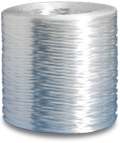Reinforcing materials
The different reinforcing materials also determine the subsequent properties of the profiles & gratings.
Fiberglass
Textile fiber is the collective term for fine fibers spun from molten glass with an approximately round cross-section. The textile glass is manufactured from high-quality E-glass and, for special applications, also from R-glass and C-glass. The relatively high strength and Young’s modulus values are a consequence of the strong bonds between silicon and oxygen in a spatial network. Due to their amorphous structure, glass fibers are isotropic, unlike carbon or aramid fibers.
After production, a sizing is applied to the freshly formed glass fiber. This bonds the filaments, protects the surface and provides a bonding agent for the matrix.
Carbon fiber
Carbon or C-fibers consist of over 90% pure carbon and have a diameter of 5-10 micrometers.
PAN (polyacrylonitrile fibers), pitch or cellulose are usually used as feedstock.
Special properties
- high strength up to approx. 2,500°C
- Very anisotropic
- negative thermal expansion in fiber direction
- thermally and electrically conductive
- good body compatibility
- sensitive to bending and pressure
- Very corrosion resistant
- Very expensive
After production, C-fibers are surface treated. In this process, the surface is oxidized to produce the largest possible number of surface oxides that can form chemical bonds with the matrix system. The surface of the fibers is given the fiber finish immediately after pretreatment. This is a substance that is initially intended to prevent the accumulation of water on the active surface and contains the functional groups for binding to the matrix system.
Aramid fiber
Aramid fibers (Kevlar) are linear, organic polymers with high strength and stiffness. Like the C-fiber, the aramid fiber exhibits a negative coefficient of thermal expansion due to its high molecular orientation (entropy effect).
Special properties
- lightest reinforcement fiber
- Very pressure sensitive
- strongly anisotropic
- strong moisture absorption
- UV sensitivity
- poor adhesion to the matrix
- poor machining
- Very expensive
The surface of the aramid fiber is chemically inert and very smooth. Thus, chemical or mechanical adhesion to the matrix is largely ruled out. The applied coating only has a protective function here.
Other fibers:
Cellulose fiber
Cellulose fiber belongs to the group of organic reinforcing fibers. It is usually made of sulfite pulp from beech wood or pure cotton cellulose.
In the early days of fiber composite technology, this fiber was used to reinforce phenolic resins. Today, it can still be found in phenolic hard paper products.
Pan fiber
Polyacrylonitrile fiber belongs to the group of synthetic organic reinforcing fibers.
PAN fiber is a high-strength fiber with a kidney-shaped cross-section. It is mainly used as a replacement material in asbestos cement products and in brake linings.
Polyethylene fiber
Polyethylene fiber belongs to the group of synthetic organic reinforcing fibers.
The PE fiber is made of highly stretched UHMW PE. Their melting point is about 150°C and they tend to creep. However, it has a high absorption capacity for impact energy and is preferably used as a hybrid material (in combination with other reinforcing fibers).
Ceramic fiber
Ceramic fiber belongs to the group of synthetic inorganic reinforcing fibers.
The ceramic fiber is used to reinforce metallic materials.
Wood fiber
Wood fiber belongs to the group of naturally organic reinforcing fibers.
Wood flours used for reinforcing phenol formaldehyde and melamine formaldehyde molding compounds are usually finely chopped wood fibers from spruce or beech wood.
Polyether fibers (PET)
Polyester fibers belong to the group of organic synthetic reinforcing fibers.
Mainly these are used for textiles. Tensile strength is about the same as polyamide fibers but impact strength exceeds most synthetic fibers. When processed in combination with glass fibers, the in composite materials leads to an improvement in impact strength.
Asbestos fiber
Asbestos fiber belongs to the group of inorganic natural reinforcing fibers.
Asbestos is the oldest inorganic fiber and was derived from natural mineral deposits (hydrated Mg and Na silicates). They are no longer used and substituted today for known reasons.
Metal fiber
The metal fibers belong to the group of synthetic inorganic reinforcing fibers.
Metal fibers can be made of steel, brass, bronze, copper, aluminum, silver, gold and platinum.
Metal fibers are used to reinforce metallic materials.
Sisal fiber
Sisal fiber belongs to the group of naturally organic reinforcing fibers.
However, despite its lower price compared to fiber optics, it failed to gain acceptance.
It was not until replacement material was sought for asbestos in the manufacture of brake linings that sisal came back into the picture.
Polyamide fiber
Polyamide fiber belongs to the group of synthetic organic reinforcing fibers.
The technically most important polyamide fibers are based on PA 66 and PA 6, which, when combined, improve elasticity and tracking resistance in particular.
Boron fiber
Boron fiber belongs to the group of synthetic inorganic reinforcing fibers.
The boron fiber is produced by the waxing process. Tungsten serves as the substrate. A thin tungsten wire is electrically heated and boron precipitates from the gas phase.
Boron fibers are used to reinforce metallic materials.
Whisker
Whisker belongs to the group of synthetic inorganic reinforcing materials.
Whiskers are synthetically produced single-crystal inorganic fibers. If this fiber can be oriented with a melt, a composite material with enormous strength is obtained.



